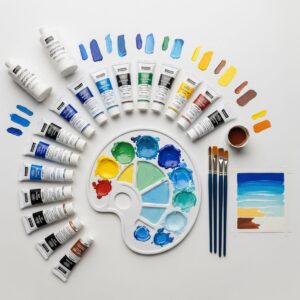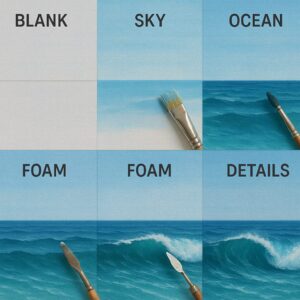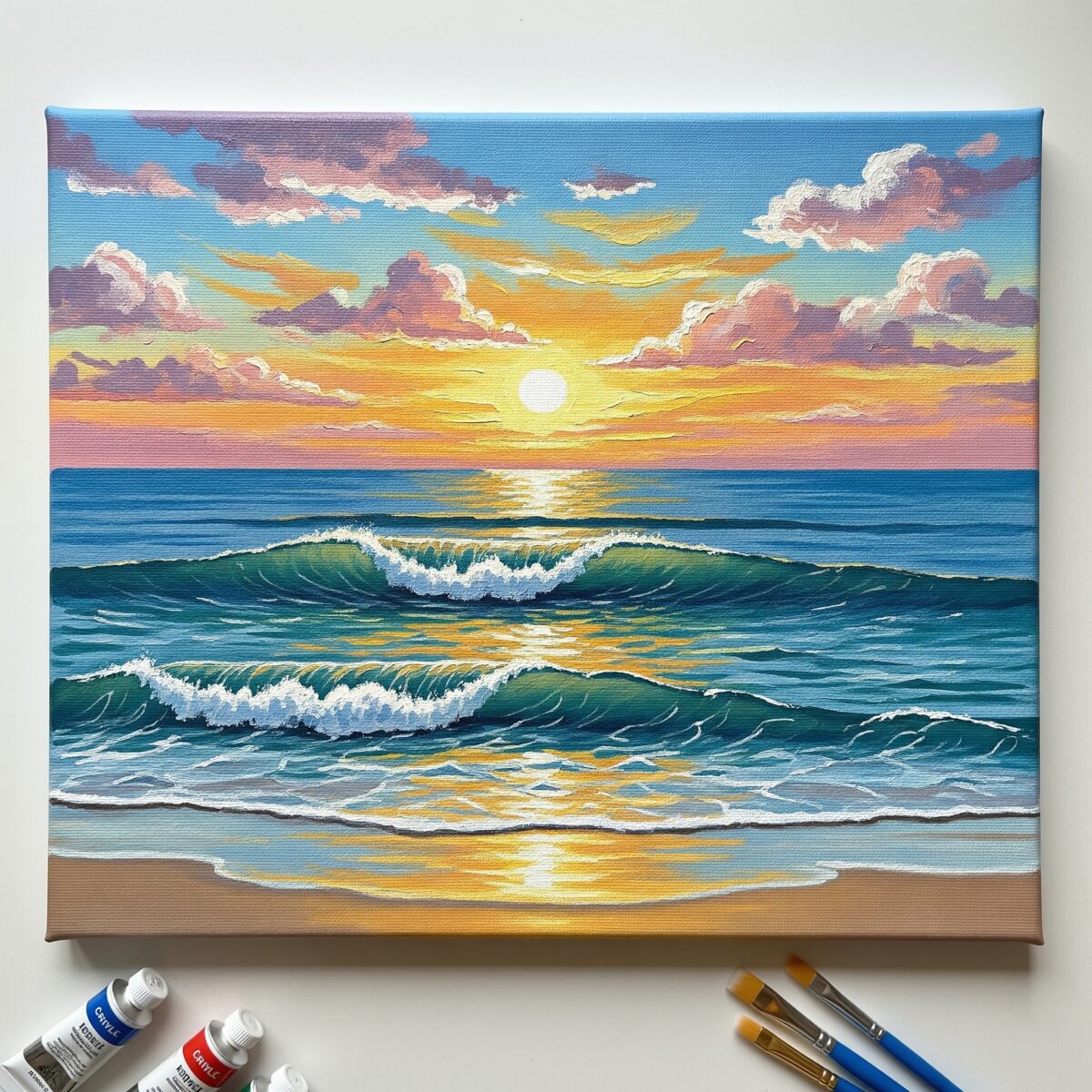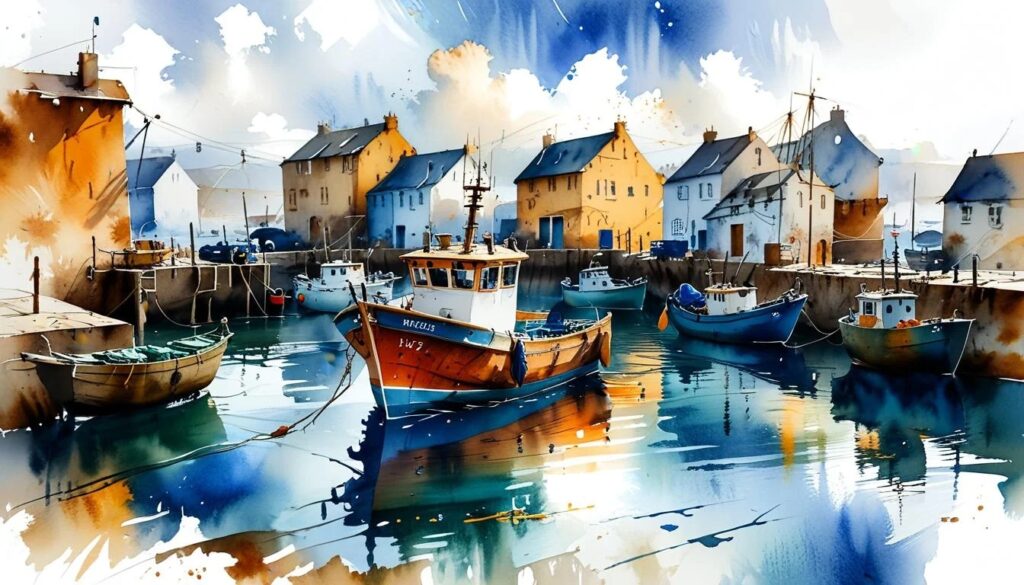Ready to dive into the world of ocean art? These easy acrylic painting ideas will help you create breathtaking seascapes that capture the magic of the sea. Whether you’re a complete beginner or looking to expand your artistic skills, acrylic paints offer the perfect medium for painting realistic waves, stunning sunsets, and peaceful coastal scenes. From simple beach paintings to dramatic ocean storms, you’ll discover step-by-step techniques that make seascape painting both fun and achievable.
Key Points Summary

- Learn 20+ beginner-friendly seascape painting ideas using acrylics
- Master essential techniques for painting realistic waves and water
- Discover the best color combinations for ocean scenes
- Get step-by-step tutorials for sunset and beach paintings
- Find tips for creating texture and movement in your seascapes
Getting Started with Acrylic Seascape Painting
Seascape painting might seem challenging at first, but with the right approach, anyone can create beautiful ocean art. Acrylic paints are perfect for beginners because they dry quickly, clean up easily with water, and offer vibrant colors that capture the essence of the sea.
The beauty of seascape painting lies in its variety. You can paint calm, peaceful waters that reflect the sky like a mirror, or dynamic waves crashing against rocky shores. Each approach teaches you different techniques while building your confidence as an artist.
Essential Supplies for Beginner Ocean Paintings
Before diving into your first seascape, gather these basic supplies:
| Supply Category | Essential Items | Optional Upgrades |
|---|---|---|
| Paints | Titanium white, ultramarine blue, cerulean blue, yellow ochre, burnt sienna | Phthalo blue, viridian green, cadmium yellow |
| Brushes | Flat brushes (sizes 4, 8, 12), round brush (size 6) | Fan brush, palette knife |
| Canvas | Pre-stretched canvas or canvas boards | Canvas pad for practice |
| Tools | Palette, water containers, paper towels | Easel, spray bottle |
Simple Color Mixing for Realistic Seascapes

Understanding color theory is crucial for creating believable ocean scenes. The sea isn’t just blue – it’s a complex mix of colors that change with lighting, weather, and depth.
Basic Ocean Color Combinations:
- Shallow water: Cerulean blue + white + touch of yellow ochre
- Deep ocean: Ultramarine blue + touch of burnt sienna
- Foam and waves: Titanium white + tiny amount of cerulean blue
- Sunset reflections: Yellow ochre + white + touch of cadmium yellow
“The secret to painting water is understanding that it’s not one color, but many colors working together to create the illusion of transparency and movement.”
Professional seascape artist
Easy Acrylic Painting Ideas: 20+ Seascape Projects
Beginner Level (Perfect for First-Time Painters)

1. Simple Sunset Seascape Start with a basic horizon line dividing your canvas in half. Paint the sky with warm sunset colors (yellow, orange, pink) and the water with cooler blues, adding horizontal brush strokes to show reflections.
2. Calm Beach Scene Create a peaceful shoreline with gentle waves lapping against sandy beach. Use light blues for shallow water and add foam with simple white brush strokes.
3. Lighthouse on Cliff Paint a dramatic lighthouse silhouette against a colorful sunset sky. This project teaches you about creating focal points and using contrast effectively.
4. Sailboat on Blue Water Practice painting simple geometric shapes with a white sailboat against deep blue ocean. Add white caps to waves for extra interest.
5. Rocky Shore Learn texture techniques by painting waves crashing against dark rocks. Use a palette knife to create realistic rock textures.
Intermediate Level (Building Your Skills)
6. Dramatic Storm Clouds Paint threatening dark clouds over choppy waters. This project teaches you about creating mood and atmosphere in your seascapes.
7. Tropical Beach Paradise Combine palm trees, white sand, and turquoise water. Learn to paint different water depths and tropical vegetation.
8. Fishing Boat at Dawn Create a peaceful morning scene with a small boat and soft, misty lighting. Practice painting reflections and subtle color transitions.
9. Crashing Waves Master the art of painting dynamic water movement with waves breaking against the shore. Focus on spray patterns and foam texture.
10. Moonlight Seascape Paint a mysterious nighttime ocean scene with moonlight reflecting on dark water. Learn about limited color palettes and creating luminous effects.
Advanced Beginner Projects
11. Seagulls Over Ocean Add life to your seascapes by including simple bird silhouettes flying over the water.
12. Tide Pools at Low Tide Paint detailed rock formations with small pools of water, teaching you about reflections in confined spaces.
13. Pier at Sunset Create perspective by painting a wooden pier extending into the ocean during golden hour.
14. Sea Cave Interior Challenge yourself with an interior view of a sea cave, focusing on light filtering through openings.
15. Winter Seascape Paint a dramatic winter ocean scene with gray skies and white-capped waves against snowy shores.
Step-by-Step Wave Painting Tutorial
Let’s break down the process of painting realistic waves:

Step 1: Establish the Horizon
Draw a light pencil line about one-third up from the bottom of your canvas. This creates a pleasing composition following the rule of thirds.
Step 2: Paint the Sky
Start with your lightest colors and work toward darker ones. Blend colors while they’re still wet for smooth transitions.
Step 3: Block in Water Base
Use horizontal brush strokes to establish the basic water color. Vary the blue tones to show depth.
Step 4: Add Wave Forms
Paint the basic wave shapes using slightly darker blues. Think of waves as rolling hills of water.
Step 5: Create Foam and Highlights
Use white paint mixed with a tiny amount of blue to paint foam on wave crests. Add this mixture while your wave colors are still slightly damp for natural blending.
Advanced Seascape Ideas for Growing Artists
16. Multi-Layered Ocean Depths Paint an underwater scene visible through clear surface water, showing fish and coral beneath.
17. Stormy Seas with Ship Create drama with a sailing vessel battling rough waters and dark storm clouds.
18. Arctic Seascape Paint icebergs floating in cold, gray-blue waters with subtle color variations.
19. Sunset Reflection Patterns Focus on complex light patterns reflecting off moving water during golden hour.
20. Coastal Cliff Panorama Paint a wide coastal view from high cliffs looking down at crashing waves below.
Bonus Ideas:
- Dolphins jumping through waves
- Beach bonfire at twilight
- Jellyfish floating in deep blue water
- Coastal wildflowers with ocean backdrop
- Marina with multiple boats
Common Mistakes to Avoid in Seascape Painting
Even experienced artists make these mistakes when starting with seascapes:
- Making water too uniform: Real water has color variations and reflections
- Ignoring light direction: Establish where your light source is and stick to it
- Overworking foam: Less is often more when painting white caps and spray
- Flat horizon lines: Add slight curves to make horizons more natural
- Wrong wave direction: Waves should flow toward the shore, not parallel to it
For more guidance on avoiding common painting mistakes, check out our comprehensive guide.
Adding Realistic Details to Your Ocean Art
Texture Techniques
- Use a dry brush technique for rough water surfaces
- Apply paint with a palette knife for rocky textures
- Blend colors while wet for smooth sky transitions
- Add salt to wet paint for unique texture effects
Creating Movement

Water is never still, so your paintings shouldn’t look static either. Use curved brush strokes to show water movement and vary your paint application from thick to thin to create visual interest.
Tips for Painting Successful Seascapes
Working with Reference Photos
While painting from imagination is fun, reference photos help you understand how light behaves on water. Free stock photos for artists can provide excellent inspiration.
Understanding Light and Shadow
Water reflects light differently than solid objects. Study how sunlight creates sparkles on water surfaces and how shadows form in wave troughs.
Building Layers
Start with thin paint layers and build up thickness gradually. This technique, similar to watercolor layering, creates depth and richness in your paintings.
YouTube Tutorial Recommendation
For visual learners, check out “Easy Ocean Painting Tutorial 🎨 Stunning Acrylic Seascape Step by Step!” on YouTube. This comprehensive video demonstrates many of the techniques discussed in this article with real-time painting demonstrations.
Taking Your Seascape Art Further
Once you’ve mastered these basic techniques, consider exploring:
- Advanced landscape painting techniques
- Different painting mediums for varied effects
- Color mixing techniques for more complex color relationships
Need Inspiration to Paint Seascapes?
| Painter | Nationality | Key Period | Notable Characteristics/Style | Famous Works (Seascape examples) |
|---|---|---|---|---|
| J.M.W. Turner | British | Romanticism | Evocative, atmospheric, focus on light and dramatic natural forces | The Fighting Temeraire, Rain, Steam and Speed – The Great Western Railway, Staffa, Fingal’s Cave |
| Claude Monet | French | Impressionism | Capturing transient effects of light and atmosphere, often in series | Impression, Sunrise, Argenteuil, The Red Boats, Cliffs at Étretat |
| Winslow Homer | American | Realism | Powerful, dramatic depictions of man’s struggle against the sea | The Gulf Stream, Northeaster, Eight Bells |
| Ivan Aivazovsky | Russian | Romanticism | Prolific, highly detailed, dramatic seascapes, often with moonlit or stormy scenes | The Ninth Wave, Rainbow, View of Constantinople by Moonlight |
| Caspar David Friedrich | German | Romanticism | Symbolic landscapes with solitary figures contemplating nature’s grandeur | The Monk by the Sea, Chalk Cliffs on Rügen |
| Albert Bierstadt | American | Romanticism | Grand, panoramic landscapes, often featuring dramatic skies and light | Storm in the Mountains, Puget Sound on the Pacific Coast |
| James Abbott McNeill Whistler | American (lived in UK) | Tonalism/Aestheticism | Subdued tones, emphasis on atmosphere and mood, often abstract | Nocturne in Blue and Gold: Old Battersea Bridge, Crepuscule in Flesh Colour and Green: Valparaiso |
| John Constable | British | Romanticism | Emphasis on naturalistic detail, changing weather and light effects | While not exclusively seascapes, his river and coastal scenes influenced later seascape painters. The Hay Wain (shows river landscape) |
Frequently Asked Questions
How do I paint ocean waves with acrylic?
Start with the basic wave shape using darker blue, then add lighter blues for the wave face. Finish with white foam on the crest, blending while the paint is still wet for natural-looking transitions.
What colors should I use for seascape painting?
Essential colors include ultramarine blue, cerulean blue, titanium white, yellow ochre, and burnt sienna. These colors can be mixed to create all the blues, greens, and earth tones needed for realistic seascapes.
What acrylic painting supplies do I need for beginners?
You’ll need basic acrylic paints, flat and round brushes, canvas or canvas boards, a palette for mixing colors, water containers, and paper towels for cleanup.
How do I paint realistic water?
Focus on color variations rather than uniform blue. Use horizontal brush strokes, add reflections of sky colors, and remember that water becomes darker as it gets deeper.
What are some acrylic painting tips for water scenes?
Work quickly while paint is wet for smooth blending, use horizontal strokes for calm water, vary your pressure for different textures, and always establish your light source first.
How do I create texture in acrylic painting?
Use different brush techniques like dry brushing for rough textures, palette knife work for rocks, and fan brushes for grass or spray effects. Varying paint thickness also creates interesting textures.
What’s the best color palette for ocean paintings?
A basic palette includes blues (ultramarine, cerulean, phthalo), white, yellow ochre, burnt sienna, and viridian green. This combination can create all the colors you need for most seascapes.
How do I paint clouds in seascape?
Start with the lightest areas using white mixed with a tiny amount of blue or pink. Add darker areas with gray mixtures, and blend edges while paint is wet for soft, natural-looking clouds.
What are some beginner painting mistakes to avoid?
Avoid making water too uniform in color, ignoring light direction, overworking foam and spray, creating perfectly straight horizons, and making waves flow in the wrong direction.
How do I paint foam and waves?
Use white mixed with a small amount of blue or gray. Apply this mixture with confident strokes along wave crests, and blend slightly with the darker water color while both are still wet.
Conclusion
These easy acrylic painting ideas for seascapes offer endless possibilities for creative expression. From simple sunset scenes to dramatic stormy waters, each project builds your skills while creating beautiful art you’ll be proud to display. Remember that every professional artist started as a beginner – the key is consistent practice and patience with yourself as you learn.
Start with the simpler projects and gradually work your way up to more complex scenes. With these easy acrylic painting ideas as your foundation, you’ll soon be creating stunning seascapes that capture the beauty and power of the ocean. The most important thing is to enjoy the process and let your creativity flow like the waves you’re painting.
For more inspiration and techniques, explore our comprehensive guides on painting techniques for beginners and discover how different art movements have influenced seascape painting throughout history.



